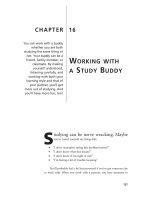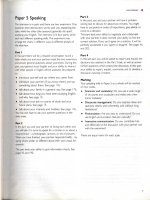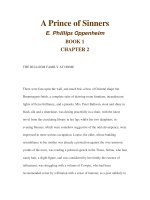Working with a study budy 2 pps
Bạn đang xem bản rút gọn của tài liệu. Xem và tải ngay bản đầy đủ của tài liệu tại đây (57.29 KB, 6 trang )
BEING YOUR OWN PARTNER
141
A
PPRECIATE YOUR OWN LEARNING STYLES
Since you’re working alone, you only have your own learning styles to
consider. This presents a good opportunity for you to make sure you’re
using methods of studying that are suitable for the way you learn. Be
aware of what works best for you and make changes if necessary. (You
may want to review Chapters 2 through 5 on learning styles.)
START WITH THE
POSITIVE
Begin a session by asking yourself what you liked about what you read,
wrote, saw, or heard. Starting out with something you enjoy and feel
comfortable with will give you a sense of accomplishment as you say to
yourself, “I know that!” Then you can face the more challenging material
with a good attitude.
U
SE SENSITIVE
TALK
Remember, you’re your partner now. Keep being sensitive to your feelings!
Use the magic word “I” even when talking to yourself. When you begin
statements with, “I like . . .” and “I feel . . . ” you’re assuming responsibility
for your opinions and feelings, and you’re respecting yourself.
As you read the next part of this chapter, talk to yourself using sen-
sitive talk. Pretend you’re talking to your partner. Begin by saying,“What
I’ve gotten out of this lesson so far is . . . ,” adding whatever comes to
mind. Continue with, “This makes me think of . . .” and keep talking until
you have a good understanding of the lesson.
R
ESPECT
YOURSELF
Be nice to yourself as you push ahead. Studying the material so that it
makes sense to you is hard work! Acknowledge your challenges. One of
the comforts of a buddy is that you have someone who knows what
you’re going through, someone who’s listening to you talk about your
hard day and who is also talking about his day. Play both roles yourself.
Try It!
HOW TO STUDY
142
Jill tells herself something like,“I know you’ve had a hard day. I wish
you could take the day off tomorrow; you’ll look into arranging for that
soon, if you can. In the meantime, is there some way you can treat your-
self, maybe take a short walk or look through a magazine, before you set-
tle down to study?”
Don’t criticize yourself! Instead, ask yourself:
• What else do I need to know to make a clear picture in my head?
• What else do I need to know so the order of events will make sense?
I
N SHORT
Whether you act like your partner or pretend your buddy is next to you,
you need to acknowledge how you’re feeling and the challenges before
you. Then you’re ready to study. Talking to yourself before, during, and
after studying helps you ask questions and make connections. This in
turn helps you to better understand and remember what you’ve studied.
Keep your thoughts in a notebook or tape recorder, so that you can go
over and add to them each study session.
1.
2.
3.
BEING YOUR OWN PARTNER
143
Practice Tips
Talking to yourself while studying, and pretending you’ve got an
invisible buddy, may seem a bit odd to you at first!
To get used to the idea and become good at it, practice before you
start your study sessions.
When you’re by yourself—in the shower, in the car, walking to work
or school—begin a conversation with yourself. To make it seem more
real, pretend you’re with a classmate. Try out questions like:
• So, how was class yesterday?
• What did you find most interesting? Puzzling?
• When is your next study session?
• What do you think you’ll need to spend the most time on during
that session?
No one’s around, so you can speak freely and pretend you’re
talking to anyone you want. Relax, and realize that you’re doing it for
a specific reason: to learn!
CHAPTER
18
PREPARING FOR
SHORT-ANSWER
TESTS
In this chapter, you’ll be
using what you’ve learned
about reading closely,
keeping calm, and using
your learning styles to
deal with tests that are
generally looking for one
specific answer to each
question. These include
true/false, matching,
multiple-choice, and
fill-in-the-blank tests.
M
any tests—classroom tests, professional
tests, and school admission exams—use the multiple
choice format, sometimes along with true/false, matching,
or fill-in-the-blank questions. These formats are similar in that they
have only one right answer.
The problem with tests that require specific answers is that
you’re either right or wrong; there’s not much room for personal
opinion. Even if you’ve studied and know the material thoroughly, you
Getting Over Test-Taking Obstacles
Tim and Tameka had been studying for exams that would qualify
them for promotions. They’d been studying for several months and
were confident they knew the material. As it got closer to test
time, they both began to panic because they knew they’d be given
a combination of different kinds of tests.
Tim told Tameka, “I think I can handle everything but fill-in-
the-blanks. I’m OK, if the right answer is there and I can find it, but
I’m really stuck if I have to come up with the name of something
on my own. I have trouble with names!”
Tameka said, “What about me? I get confused when I see a
bunch of answers that are similar to each other and I have to
choose the one that’s right. I say to myself, ‘Well, maybe under cer-
tain circumstances choice A would be correct, but then again,
choice B would work in a different situation.’ I do it every time!”
Tim has a problem coming up with the right names, and Tame-
ka has a problem when answer choices are very similar. What Tim
needs to do is learn to associate names with meanings, and Tame-
ka needs to come up with an answer before looking at the choices.
HOW TO STUDY
146
still may find some questions challenging. That’s because these tests are
often designed to be tricky: multiple-choice tests offer “close” answers in
addition to the correct one; matching tests use words out of context. So
in addition to knowing the subject matter, you’ve got to learn how to take
these kinds of tests, and this includes making up your own practice test.
STUDYING FOR A TEST
The best way to study for a test is to test yourself, or have your study
buddy test you.
T
ESTING
YOURSELF
Creating a test of your own forces you to think like a teacher. As you
develop questions, you hone in on what’s most important in what you’re
studying. This helps you understand the material better, and it gives you
more confidence in yourself. It also helps you become more responsible
for your own learning. When you make up a test like this, you are doing









